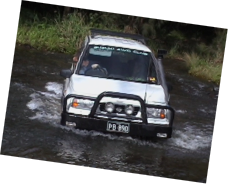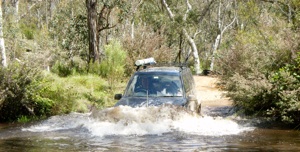Tackling different terrains

Water crossings
NEVER plunge into an unknown creek without getting out and thoroughly checking it.
Walk right across the creek, looking for hidden boulders, submerged logs or deep holes.
You need to check a track at least as wide as your car, not just wade across and back in your own footprints.
Hidden obstacles will need to be marked with sticks.
Check the entry point to the water. Is it steep? Steep entries can often force the nose of the car quite deep into the water.



Preparation is the key to a successful and safe water crossing. If the engine takes in water, it can do untold damage. Water and the internal combustion engine have never been best of friends.
Finally, check the exit at the other side to make sure you can get out. Many exits are steep and don't forget it will end up quite muddy.
Once exited the crossing stop in a suitable place so as to allow the majority of the water from under the car to drain back into the river. This will reduce the amount of mud that will be made on the exit. Although this is not always possible.
By now you should know exactly what you are up against. The depth, the strength of the current, any hidden obstacles, and your exact track across.


SRODRV001B/04 USE THE FEATURES OF A 4WD TO DRIVE A VARIETY OF TERRAIN TYPES
PERFORMANCE CRITERIA 04h

